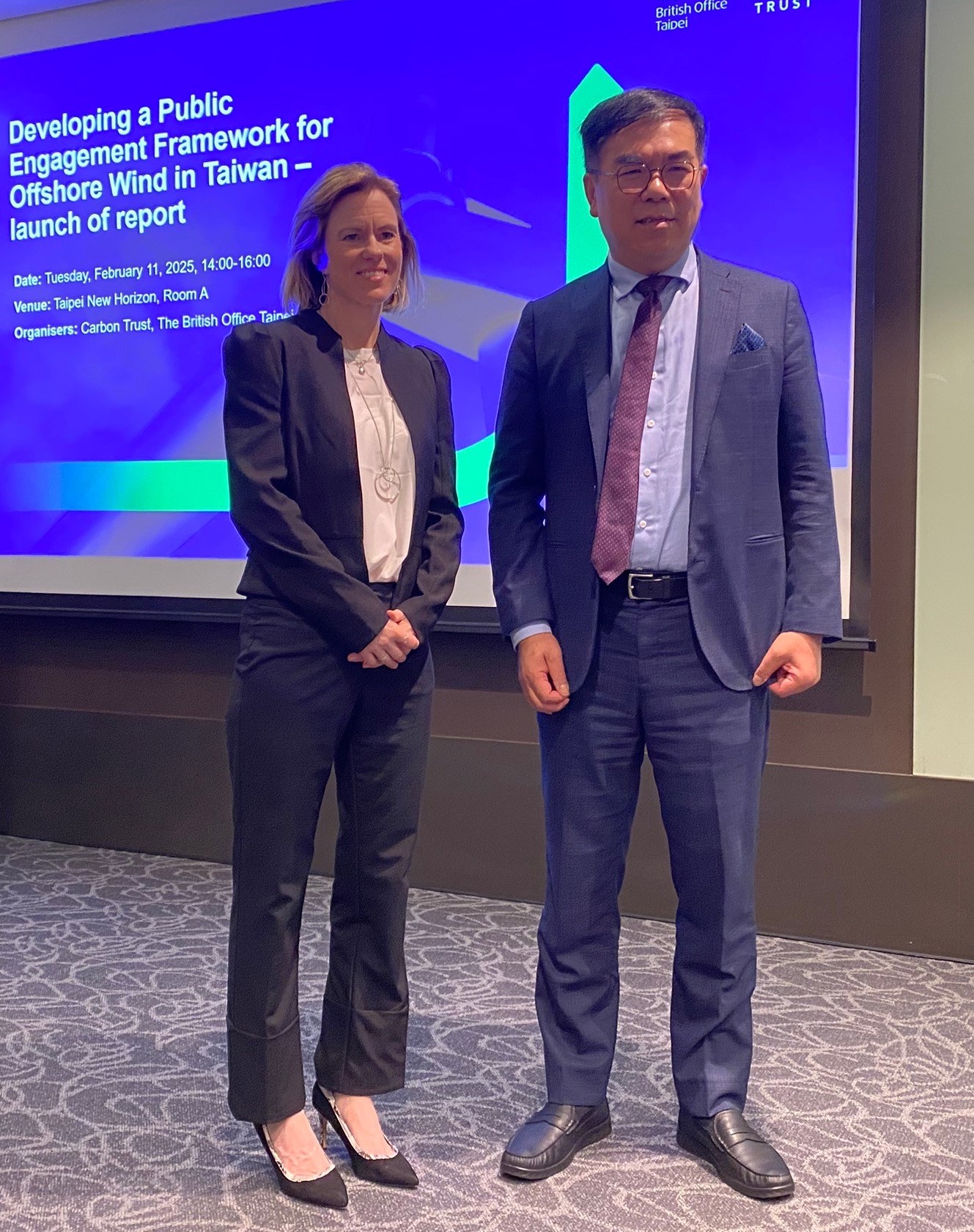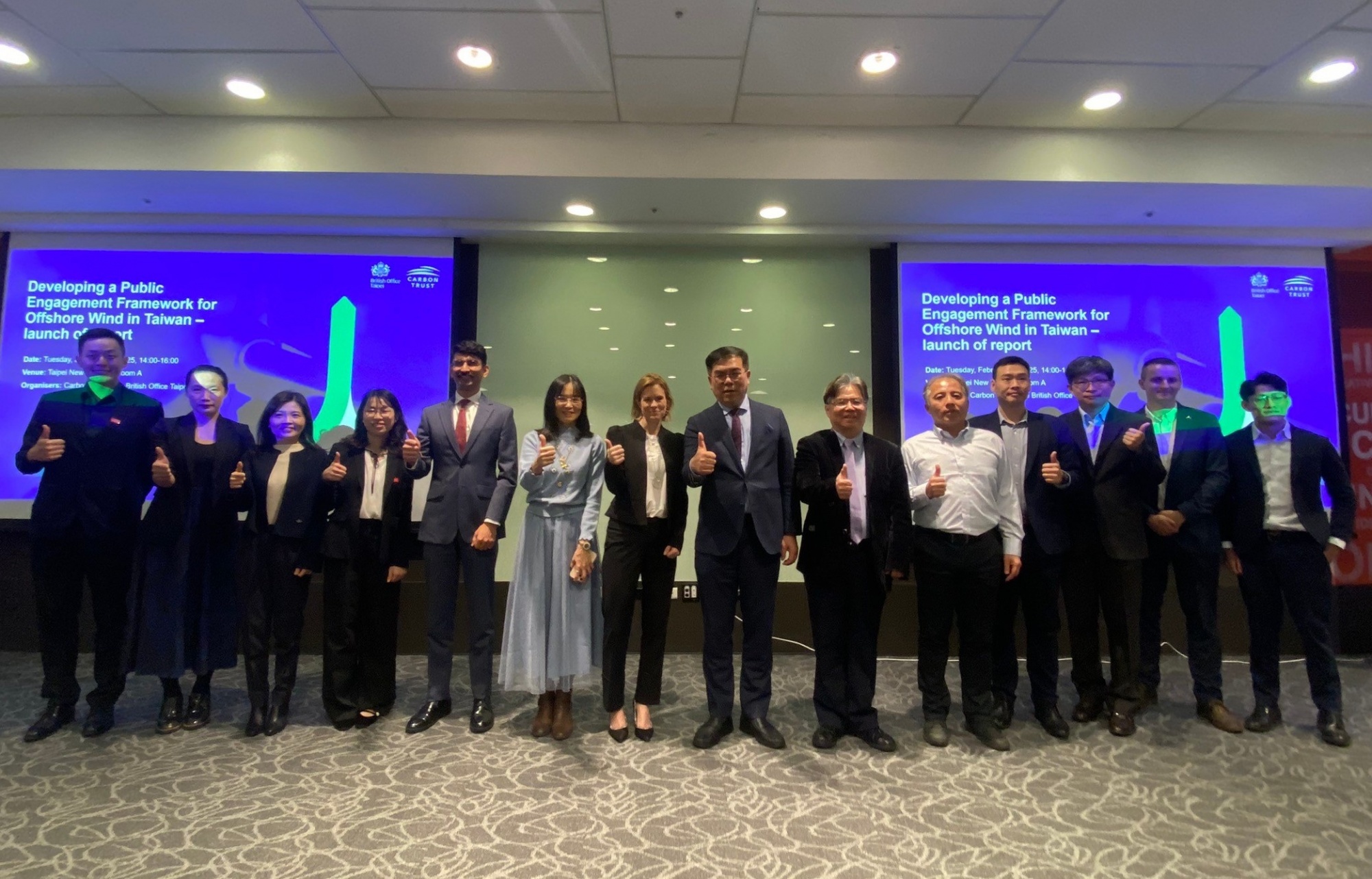Carbon Trust Hosts "Developing a Public Engagement Framework for Offshore Wind in Taiwan - launch of report" Highlighting 4 Core Components
Carbon Trust Hosts "Developing a Public Engagement Framework for Offshore Wind in Taiwan - launch of report" Highlighting 4 Core Components
 (Left to right) Ruth Bradley-Jones, Representative at the British Office Taipei|Chi-Ming Peng, Minister of MOENV
(Left to right) Ruth Bradley-Jones, Representative at the British Office Taipei|Chi-Ming Peng, Minister of MOENV
The British Office and Carbon Trust co-hosted a report briefing titled "Developing a Public Engagement Framework for Offshore Wind in Taiwan – Launch of Report" on February 11. The event convened key stakeholders in Taiwan's offshore wind development—including government agencies, industry leaders, experts, and civil society groups—for in-depth discussions on promoting the sustainable growth of the sector.
Taiwan has emerged as a leader in offshore wind development within the Asia-Pacific region. By the end of last year (2024), the nation's installed capacity had reached 3 GW, ranking seventh globally. Neighboring countries have even begun to draw on Taiwan's wind energy experience—a feat that plays an indispensable role in achieving Taiwan’s 2050 net-zero carbon goal. As offshore wind capacity continues to expand, public engagement and effective communication become ever more critical, not only to bolster support for renewable energy but also to ensure community acceptance and long-term sustainability. In light of these developments, Carbon Trust conducted a series of interviews with stakeholders and experts in Taiwan's offshore wind sector to explore the opportunities and challenges.
Ruth Bradley-Jones, Representative at the British Office Taipei, stated: "Climate change is a collective challenge that requires coordinated action. The United Kingdom is committed to forging partnerships to drive proactive climate action and deliver sustainable solutions. Despite the myriad challenges facing the global environment, Taiwan has made impressive strides in the development of offshore wind energy. Once the wind farms currently under construction become operational, Taiwan will boast the world’s fifth-largest offshore wind capacity. However, the energy transition is not without its challenges—it necessitates strategic planning, stakeholder engagement, and innovative marine spatial planning to overcome them. Having embarked on offshore wind development several years ahead of Taiwan, the United Kingdom has a wealth of valuable experience to share. This report, prepared and released by the Carbon Trust team, draws on international experience—including insights from the UK—and offers recommendations to enhance Taiwan’s public engagement mechanisms. We hope these suggestions will prove beneficial and look forward to witnessing an accelerated energy transition in the coming years."
Chi-Ming Peng, Minister of MOENV added: "Taiwan has established its third Nationally Determined Contribution (NDC 3.0) target, aiming for a 38±2% reduction in carbon emissions by 2035, with renewable energy accounting for 36% of total power generation. To achieve these targets, we will focus on measures such as deep energy conservation, transportation electrification, reducing coal consumption, and increasing the share of renewable energy. Offshore wind development is a critical component of this strategy, with a projected capacity of 18.4 GW by 2035. While the environmental impact assessment process for offshore wind projects—overseen by MOENV—may not be perfect, its review procedures are conducted with complete impartiality and transparency. We are also working to improve the efficiency of the process and are reviewing related regulations. I extend my gratitude to the British Office and Carbon Trust for co-hosting this event and for their recommendations and experience sharing on the public engagement framework for offshore wind. We look forward to continued dialogue on this issue."
The report offers an in-depth examination of the key challenges faced in Taiwan's offshore wind public engagement process and presents several critical recommendations for enhancing its effectiveness. It first identifies challenges inherent in the current process—such as ineffective communication, a lack of transparency, and community concerns regarding the impact of development projects. By analyzing international best practices, the report distills lessons from mature offshore wind markets, highlighting how to incorporate community voices into decision-making and build a foundation of trust and collaboration. Specifically, the report outlines the following core components:
1. Key Principles and Mechanisms:
Establish a set of fundamental public engagement principles—including transparency, inclusiveness, and respect for diverse opinions—to ensure that the perspectives of all stakeholders are fully heard.
2. Adopting Best Practices:
Draw on successful international case studies and integrate these practices with Taiwan’s unique context, proposing tailored recommendations that reflect local cultural and social structures to enhance public engagement.
3. A Transparent Engagement Framework:
Introduce a clear and robust framework to guide the planning and implementation of offshore wind projects, facilitating long-term cooperation between developers and communities while mitigating potential conflicts.
4. A Multi-Stakeholder Governance Committee:
Emphasize the importance of establishing a governance committee comprising various stakeholders to enable collective discussion and problem-solving, as well as to conduct ongoing community interaction and needs assessments.
As Taiwan continues to consolidate its leadership in offshore wind within the Asia-Pacific region, it is hoped that the recommendations outlined in this report will significantly enhance the sustainability and inclusiveness of energy projects, thereby contributing to the nation's goal of achieving net-zero emissions by 2050.

